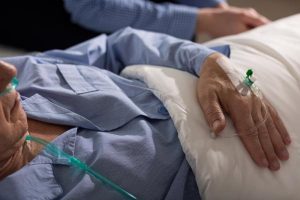- Home
- Editorial
- News
- Practice Guidelines
- Anesthesiology Guidelines
- Cancer Guidelines
- Cardiac Sciences Guidelines
- Critical Care Guidelines
- Dentistry Guidelines
- Dermatology Guidelines
- Diabetes and Endo Guidelines
- Diagnostics Guidelines
- ENT Guidelines
- Featured Practice Guidelines
- Gastroenterology Guidelines
- Geriatrics Guidelines
- Medicine Guidelines
- Nephrology Guidelines
- Neurosciences Guidelines
- Obs and Gynae Guidelines
- Ophthalmology Guidelines
- Orthopaedics Guidelines
- Paediatrics Guidelines
- Psychiatry Guidelines
- Pulmonology Guidelines
- Radiology Guidelines
- Surgery Guidelines
- Urology Guidelines
AIIMS doctors develop model to predict shock 12 hours in advance

The AIIMS-led multi-institutional team of researchers has developed a machine-learning algorithm to detect shock even 12 hours before it can be clinically recognized by doctors by using the current gold standard (intra-arterial blood pressure).
The study published in the journal Scientific Reports has revealed that the machine-learning algorithm to detect shock at the time a single photo is taken using thermal imaging has an accuracy of 75%. The ability of the algorithm to forecast the probability of a shock happening three, six and 12 hours before clinical recognition can be done using the gold standard method is 77%, 69%, and 69% respectively. The algorithm was used in conjunction with pulse rate to both detect and predict shock.
Thermal imaging is a non-invasive, non-contact modality to capture body surface temperature with the potential to reveal underlying perfusion disturbance in shock.
Read Also: Shocking report- Risk of heart attack increases during Christmas holiday
“Our study demonstrates that affordable and compact thermal imaging can effectively capture the CPD gradient that may inform shock diagnosis and prediction”, write the authors.
Shock is a clinical state of mismatch between the demand and supply of cellular oxygen. It is most commonly associated with fluid loss (hypovolemia), inefficient pumping (cardiogenic) or infections (septic) that cause the redistribution of fluids within the body. All three mechanisms contribute, often in combination, to shock in the intensive care unit (ICU).
In pediatric intensive care units, 70-90% babies develop signs of sepsis. Almost 30% of pediatric ICU patients suffer from sepsis shock and 30% of them end up dying due to multiorgan failure.
“This number will be much higher at district hospitals. Sepsis shock is one major killer in pediatric ICUs,” says Dr. Tavpritesh Sethi from the Department of Paediatrics at AIIMS, New Delhi, who led the team. In principle, the model can be used for predicting shock in adult patients too. But the model has to be tested on adults as the current study was limited to 539 thermal images of pediatric patients.
According to the authors, it is possible to prevent organ failure and death by adopting simple measures such as fluid management through transfusion and raising the blood pressure using certain drugs. Body starts responding to shock very quickly but takes some time for clinical recognition. This is where the machine-learning algorithm comes handy in saving lives with its ability to detect and predict shock.
Read Also: Ultrasound within 1 hour of ICU admission confirms type of shock
Just like temperature difference between the peripheral and center of the body, the pulse rate increases when shock sets in. Pulse rate increases in response to reduced blood and oxygen supply. The heart beats faster to circulate the smaller volume of blood causing a higher pulse rate.
Since a single image along with pulse rate is all that is required for detecting and predicting shock, children admitted in ICUs at remote locations can be monitored using the model as a telediagnostic decision support system.
The potential to scale beyond the intensive care settings to emergency rooms and the community has made the study especially valuable for decision making for shock in resource-limited settings.
The research team is also planning to launch a smartphone application which will incorporate the model capability to predict shock.
For full 9information log on to https://www.nature.com/articles/s41598-018-36586-8#Abs1

Disclaimer: This site is primarily intended for healthcare professionals. Any content/information on this website does not replace the advice of medical and/or health professionals and should not be construed as medical/diagnostic advice/endorsement or prescription. Use of this site is subject to our terms of use, privacy policy, advertisement policy. © 2020 Minerva Medical Treatment Pvt Ltd